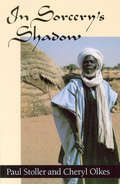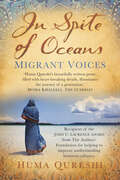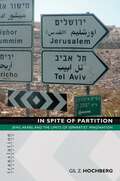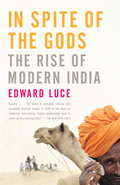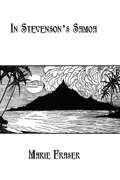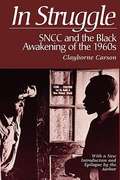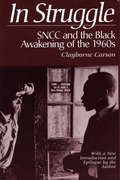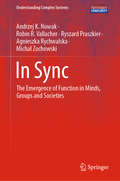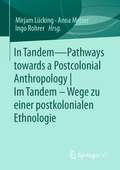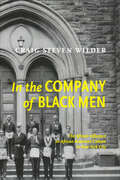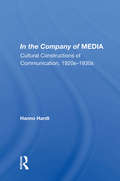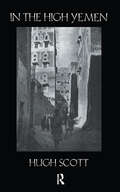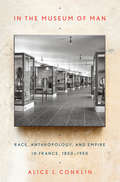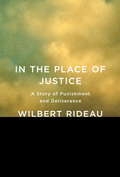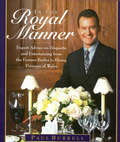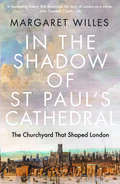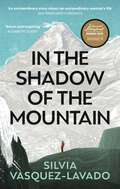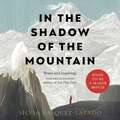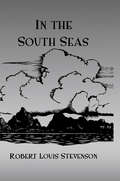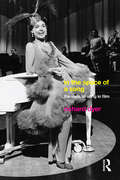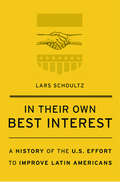- Table View
- List View
In Sorcery's Shadow: A Memoir of Apprenticeship among the Songhay of Niger
by Paul Stoller Cheryl OlkesThe tale of Paul Stoller's sojourn among sorcerors in the Republic of Niger is a story of growth and change, of mutual respect and understanding that will challenge all who read it to plunge deeply into an alien world.
In Spite of Innocence: Erroneous Convictions in Capital Cases
by Michael L. Radelet Hugo Adam Bedau Constance E. PutnamA serious indictment of our biased legal system.
In Spite of Oceans: Migrant Voices
by Huma QureshiIn Spite of Oceans: Migrant Voices explores the individual journeys of generations in transition from the South Asian subcontinent to England. Poignantly written, and based on real events and interviews, what emerges is the story of lives between cultures, of families reconciling customs and traditions away from their ancestral roots, and of the tensions this necessarily creates. We hear from the young bride from Bangladesh, married to a stranger, who comes to England to navigate life with a man she cannot love; from an Indian father who struggles to come to terms with his son's mental illness and hides it from people he knows; about how a mother and daughter's relationship was shattered in the clash over the Pakistani traditions her daughter chooses not to follow. Each narrative describes a journey that is both literal and deeply emotional, exploring the hold an inherited culture can have on the decisions and choices we make. At times heart-breaking, at times inspirational, In Spite of Oceans brings to life the pull of the past and the push of the future, and the evolving nature of what we understand as home.
In Spite of Partition: Jews, Arabs, and the Limits of Separatist Imagination (Translation/Transnation #17)
by Gil Z. HochbergPartition--the idea of separating Jews and Arabs along ethnic or national lines--is a legacy at least as old as the Zionist-Palestinian conflict. Challenging the widespread "separatist imagination" behind partition, Gil Hochberg demonstrates the ways in which works of contemporary Jewish and Arab literature reject simple notions of separatism and instead display complex configurations of identity that emphasize the presence of alterity within the self--the Jew within the Arab, and the Arab within the Jew. In Spite of Partition examines Hebrew, Arabic, and French works that are largely unknown to English readers to reveal how, far from being independent, the signifiers "Jew" and "Arab" are inseparable. In a series of original close readings, Hochberg analyzes fascinating examples of such inseparability. In the Palestinian writer Anton Shammas's Hebrew novel Arabesques, the Israeli and Palestinian protagonists are a "schizophrenic pair" who "have not yet decided who is the ventriloquist of whom." And in the Moroccan Jewish writer Albert Swissa's Hebrew novel Aqud, the Moroccan-Israeli main character's identity is uneasily located between the "Moroccan Muslim boy he could have been" and the "Jewish Israeli boy he has become." Other examples draw attention to the intricate linguistic proximity of Hebrew and Arabic, the historical link between the traumatic memories of the Jewish Holocaust and the Palestinian Nakbah, and the libidinal ties that bind Jews and Arabs despite, or even because of, their current animosity.
In Spite of the Gods: The Rise of Modern India
by Edward LuceAs the world's largest democracy and a rising international economic power, India has long been heralded for its great strides in technology and trade. Yet it is also plagued by poverty, illiteracy, unemployment, and a vast array of other social and economic issues. Here, noted journalist and formerFinancial TimesSouth Asia bureau chief Edward Luce travels throughout India's many regions, cultures, and religious circles, investigating its fragile balance between tradition and modernity. From meetings with key political figures to fascinating encounters with religious pundits, economic gurus, and village laborers,In Spite of the Godsis a fascinating blend of analysis and reportage that comprehensively depicts the nuances of India's complex situation and its place in the world.
In Stevenson'S Samoa
by FraserFirst published in 2006. Routledge is an imprint of Taylor & Francis, an informa company.
In Struggle: SNCC and the Black Awakening of the 1960s
by Clayborne CarsonThis book is a great account of the Student Non-violent Coordinating Committee.
In Struggle: SNCC and the Black Awakening of the 1960s, With a New Introduction and Epilogue by the Author (Civil Rights And The Struggle For Black Equality In The Twentieth Century Ser.)
by Clayborne CarsonWith its radical ideology and effective tactics, the Student Nonviolent Coordinating Committee (SNCC) was the cutting edge of the civil rights movement during the 1960s. This sympathetic yet evenhanded book records for the first time the complete story of SNCC’s evolution, of its successes and its difficulties in the ongoing struggle to end white oppression. At its birth, SNCC was composed of black college students who shared an ideology of moral radicalism. This ideology, with its emphasis on nonviolence, challenged Southern segregation. SNCC students were the earliest civil rights fighters of the Second Reconstruction. They conducted sit-ins at lunch counters, spearheaded the freedom rides, and organized voter registration, which shook white complacency and awakened black political consciousness. In the process, Clayborne Carson shows, SNCC changed from a group that endorsed white middle-class values to one that questioned the basic assumptions of liberal ideology and raised the fist for black power. Indeed, SNCC’s radical and penetrating analysis of the American power structure reached beyond the black community to help spark wider social protests of the 1960s, such as the anti–Vietnam War movement. Carson’s history of SNCC goes behind the scene to determine why the group’s ideological evolution was accompanied by bitter power struggles within the organization. Using interviews, transcripts of meetings, unpublished position papers, and recently released FBI documents, he reveals how a radical group is subject to enormous, often divisive pressures as it fights the difficult battle for social change.
In Sync: The Emergence of Function in Minds, Groups and Societies (Understanding Complex Systems)
by Ryszard Praszkier Robin R. Vallacher Agnieszka Rychwalska Andrzej K. Nowak Michal ZochowskiThis book introduces the reader to the concept of functional synchronization and how it operates on very different levels in psychological and social systems – from the emergence of thought to the formation of social relations and the structure of societies. For years, psychologists have investigated phenomena such as self-concept, social judgment, social relations, group dynamics, and cooperation and conflict, but have discussed these phenomena seoarately.This book shows how synchronization provides a foundational approach to these otherwise distinct and diverse psychological processes.This work shows that there is a basic tendency with many processes to become coordinated and progressively integrated into increasingly larger units through well-defined processes. For these larger units, new and largely adaptive functions emerge. Although synchronization affords progressive integration of system elements to enable correspondingly higher-order functions, the trajectory of synchronization is often characterized by periods of assembly and disassembly of system elements. This occurs when a task is completed and synchronization is no longer essential so that the elements once again operate in an independent fashion. It is argued that the disassembly-resynchronization scenario occurs at all levels of psychological and social reality. The implications of this approach for important issues in interpersonal relations and societal processes are discussed.
In Tandem – Pathways towards a Postcolonial Anthropology | Im Tandem – Wege zu einer postkolonialen Ethnologie
by Ingo Rohrer Mirjam Lücking Anna MeiserPostkoloniale Ansätze in der Ethnologie zeichnen sich durch eine kritische Reflexion der eigenen Wissenschaftsgeschichte aus und denken dabei theoretische und methodologische Ansätze des Faches weiter. Sie laden dazu ein, sich kritisch mit der Verstrickung der Disziplin in koloniale Prozesse und der Aufrechterhaltung von ungleichen Machtstrukturen auseinanderzusetzen. Postkoloniale Ansätze hinterfragen die Autorität ethnologischer Wissenskonstruktion und die damit verbundene Repräsentation des kulturell „Anderen“ sowie des „Eigenen“. Darüber hinaus lenkt eine postkoloniale Ethnologie den Blick auf transkulturelle Verflechtungen, etwa lokale Interpretationen globaler Symbole und Praktiken. Damit destabilisiert sie vermeintlich „universale“ Erklärungsmuster und Konzepte, verortet sie in Zeit und Raum.Die Beiträge in diesem, Judith Schlehe gewidmeten Sammelband veranschaulichen, welche fruchtbaren Implikationen ein postkolonialer Impetus für die ethnologische Forschung, Theorie und Praxis bereithalten kann. Angelehnt an die von Judith Schlehe entwickelte „Tandem“-Forschung stellen die AutorInnen in ihren eigenen Studien kollaborative und kulturell reziproke Prozesse vor. Sie zeigen alternative Deutungen zu „westlichen“ Sichtweisen auf und verdeutlichen deren Relevanz für das Fach.
In The Absence of the Sacred: The Failure of Technology and the Survival of the Indian Nations
by Jerry ManderWith In the Absence of the Sacred, he goes beyond television to critique our technological society as a whole. In this provocative work, Mander challenges the utopian promise of technological society and tracks its devastating impact on native cultures worldwide. The Western world's loss of a sense of the sacred in the natural world, he says, has led us toward global environmental disaster and social disorder--and worse lies ahead. Yet models for restoring our relationship with the Earth exist in the cultures of native peoples, whose values and skills have enabled them to survive centuries of invasion and exploitation. Far from creating paradise on Earth, technology has instead produced an unsustainable contest for resources. Mander surveys the major technologies shaping the "new world order"--computers, telecommunications, space exploration, genetic engineering, robotics, and the corporation itself--and warns that they are merging into a global mega-technology, with dire environmental and political results.
In The Company Of Black Men: The African Influence on African American Culture in New York City
by Craig Steven WilderTraces the development of African-American community traditions over three centuriesFrom the subaltern assemblies of the enslaved in colonial New York City to the benevolent New York African Society of the early national era to the formation of the African Blood Brotherhood in twentieth century Harlem, voluntary associations have been a fixture of African-American communities.In the Company of Black Men examines New York City over three centuries to show that enslaved Africans provided the institutional foundation upon which African-American religious, political, and social culture could flourish. Arguing that the universality of the voluntary tradition in African-American communities has its basis in collectivism—a behavioral and rhetorical tendency to privilege the group over the individual—it explores the institutions that arose as enslaved Africans exploited the potential for group action and mass resistance. Craig Steven Wilder’s research is particularly exciting in its assertion that Africans entered the Americas equipped with intellectual traditions and sociological models that facilitated a communitarian response to oppression. Presenting a dramatic shift from previous work which has viewed African-American male associations as derivative and imitative of white male counterparts, In the Company of Black Men provides a ground-breaking template for investigating antebellum black institutions.
In The Company Of Media: Cultural Constructions Of Communication, 1920's To 1930's
by Hanno HardtThis book explores the imaginative construction of a cultural history of the media in a series of essays that draw on various artistic and intellectual narratives of Western societies and trace incidental encounters with the means of social communication in cultural and political settings.
In The Company Of Men: Male Dominance And Sexual Harassment (Northeastern Series On Gender, Crime, And Law Ser.)
by Phoebe Morgan James E. GruberDespite over twenty years of discussion and study, sexual harassment remains a significant problem in the workplace. Current research focusing on organizational policy and women's career development often ignores the reality of male dominance, prevalent in areas such as the military, the police, and firefighting-occupations that see not only more frequent but also more severe harassment, even sexual assault. Meanwhile, new evidence points to the fact that men are largely responsible not only for the harassment of women but for most harassment of other men as well. This landmark collection of original essays investigates the links between male dominance and sexual harassment in light of new research and more complex understandings of masculinity. Treated not merely as a matter of worker sex ratios but as an inherent element of workplace culture, male dominance is observed from a variety of quantitative and qualitative approaches ranging from criminology and sociology to psychology and gender studies. Integrating both men's and women's viewpoints, research across occupational groups, and studies from both the United States and Europe, the chapters provide an invaluable international perspective into two inextricably intertwined problems rooted in cultural constructions of gender and institutional roles and processes.
In The High Yemen
by ScottFirst Published in 2002. Routledge is an imprint of Taylor & Francis, an informa company.
In The Margins: On The Pleasures Of Reading And Writing
by Ann Goldstein Elena FerranteIn 2020, Claire Luchette in O, The Oprah Magazine described the beloved Italian novelist Elena Ferrante as “an oracle among authors.” Here, in these four crisp essays, Ferrante offers a rare look at the origins of her literary powers. She writes about her influences, her struggles, and her formation as both a reader and a writer; she describes the perils of “bad language” and suggests ways in which it has long excluded women’s truth; she proposes a choral fusion of feminine talent as she brilliantly discourses on the work of Emily Dickinson, Gertrude Stein, Ingeborg Bachmann, and many others. Here is a subtle yet candid book by “one of the great novelists of our time” about adventures in literature, both in and out of the margins.
In The Museum Of Man: Race, Anthropology, and Empire in France, 1850–1950
by Alice L. ConklinIn the Museum of Man offers new insight into the thorny relationship between science, society, and empire at the high-water mark of French imperialism and European racism. Alice L. Conklin takes us into the formative years of French anthropology and social theory between 1850 and 1900; then deep into the practice of anthropology, under the name of ethnology, both in Paris and in the empire before and especially after World War I; and finally, into the fate of the discipline and its practitioners under the German Occupation and its immediate aftermath. Conklin addresses the influence exerted by academic networks, museum collections, and imperial connections in defining human diversity socioculturally rather than biologically, especially in the wake of resurgent anti-Semitism at the time of the Dreyfus Affair and in the 1930s and 1940s. Students of the progressive social scientist Marcel Mauss were exposed to the ravages of imperialism in the French colonies where they did fieldwork; as a result, they began to challenge both colonialism and the scientific racism that provided its intellectual justification. Indeed, a number of them were killed in the Resistance, fighting for the humanist values they had learned from their teachers and in the field. A riveting story of a close-knit community of scholars who came to see all societies as equally complex, In the Museum of Man serves as a reminder that if scientific expertise once authorized racism, anthropologists also learned to rethink their paradigms and mobilize against racial prejudice a lesson well worth remembering today.
In The Place of Justice: A Story of Punishment and Deliverance
by Wilbert RideauFrom Wilbert Rideau, the award-winning journalist who spent forty-four years in Louisiana prisons working against unimaginable odds to redeem himself, the story of a remarkable life: a crime, its punishment, and ultimate triumph. After killing a woman in a moment of panic following a botched bank robbery, Rideau, denied a fair trial, was improperly sentenced to death at the age of nineteen. After more than a decade on death row, his sentence was amended to life imprisonment, and he joined the inmate population of the infamous Angola penitentiary. Soon Rideau became editor of the prison newsmagazineThe Angolite,which under his leadership became an uncensored, daring, and crusading journal instrumental in reforming the violent prison and the corrupt Louisiana justice system. With the same incisive feel for detail that brought Rideau great critical acclaim, here he brings to vivid life the world of the prison through the power of his pen. We see Angola's unique culture, encompassing not only rivalries, sexual slavery, ingrained racism, and daily, soul-killing injustices but also acts of courage and decency by keeper and kept alike. As we relive Rideau's remarkable rehabilitation--he lived a more productive life in prison than do most outside--we also witness his long struggle for justice. In the Place of Justicegoes far beyond the confines of a prison memoir, giving us a searing exposé of the failures of our legal system framed within the dramatic tale of a man who found meaning, purpose, and hope in prison. This is a deeply moving, eloquent, and inspirational story about perseverance, unexpected friendships and love, and the possibility that good can be forged under any circumstances. From the Hardcover edition.
In The Royal Manner: Expert Advice on Etiquette and Entertaining from the Former Butler to Diana, Princess of Wales
by Paul BurrellFor more than twenty years, Paul Burrell has enjoyed an extraordinary connection with the British Crown. Starting out as footman to Queen Elizabeth, he went on to become Princess Diana's butler and her closest confidant, the man she referred to as her "rock." The Prince and Princess of Wales were famed for the superb style in which they entertained, and Paul Burrell oversaw every aspect of each soiree, from the simplest of brunches to the most elaborate dinner parties, both at home and abroad. Now this expert on etiquette and palace life reveals the secrets of royal style and how you too can host events In the Royal Manner. What is the proper order of courses in a meal? How many glasses and pieces of cutlery should be at each place setting? How does a butler in Buckingham Palace decant a wine? How can you give your overnight guests the true royal treatment? In this fully illustrated, lavishly produced volume, Paul Burrell escorts you through a typical year of seasonal occasions. Here are detailed guidelines on etiquette and entertaining, as well as the royal standards for teas, picnics, children's parties, simple suppers and brunches, holiday meals, formal weddings, and other celebrations. Unique to this book are the menus and more than fifty longtime popular recipes (including particular favorites of Princess Diana such as Pears in Port Wine with Cinnamon Ice Cream), classic Victorian dishes, and the ever-stylish Pimms, a cool summer cocktail made with fruited lemonade and gin. Paul Burrell also shares his knowledge of palace history and lore, along with his special perspective on the traditions of the royal family and his treasured memories of the late Princess of Wales. From detailed directions on how to fold napkins into elegant designs, to tips on formal seating arrangements and proper table manners, to step-by-step instructions for creating elaborate floral centerpieces, In the Royal Manner has everything you need to make a party in your home truly fit for a king.
In The Shadow of St. Paul's Cathedral: The Churchyard that Shaped London
by Margaret WillesThe extraordinary story of St. Paul’s Churchyard—the area of London that was a center of social and intellectual life for more than a millennium St. Paul’s Cathedral stands at the heart of London, an enduring symbol of the city. Less well known is the neighborhood at its base that hummed with life for over a thousand years, becoming a theater for debate and protest, knowledge and gossip. For the first time Margaret Willes tells the full story of the area. She explores the dramatic religious debates at Paul’s Cross, the bookshops where Shakespeare came in search of inspiration, and the theater where boy actors performed plays by leading dramatists. After the Great Fire of 1666, the Churchyard became the center of the English literary world, its bookshops nestling among establishments offering luxury goods. This remarkable community came to an abrupt end with the Blitz. First the soaring spire of Old St. Paul’s and then Wren’s splendid Baroque dome had dominated the area, but now the vibrant secular society that had lived in their shadow was no more.
In The Shadow of the Mountain
by Silvia Vasquez-Lavado*****'Silvia Vasquez-Lavado is a warrior. I'm in awe of her strength and courage.' - Selena Gomez'powerful' - New York TimesIn the Shadow of the Mountain has all the elements a great memoir requires - a strong voice, cinematic prose, a hero to root for - in essence, an extraordinary story about an extraordinary woman's life.' - San Francisco Chronicle'Silvia Vasquez-Lavado is a woman possessed of uncommon strength, rare compassion, and a ferocious stubbornness to not allow the trauma of her childhood to destroy her life.' - Elizabeth Gilbert, author of Eat, Pray, Love YOU DON'T CONQUER A MOUNTAIN. YOU SURRENDER TO IT ONE STEP AT A TIME. Despite a high-flying career, Silvia Vasquez-Lavado knew she was hanging by a thread. Deep in the throes of alcoholism, and hiding her sexuality from her family, she was repressing the abuse she'd suffered as a child.When her mother called her home to Peru, she knew something finally had to change. It did. Silvia began to climb. Something about the sheer size of the mountains, the vast emptiness and the nearness of death, woke her up. And then, she took her biggest pain to the biggest mountain: Everest. The 'Mother of the World' allows few to reach her summit, but Silvia didn't go alone. Trekking with her to Base Camp, were five troubled young women on an odyssey that helped each confront their personal trauma, and whose strength and community propelled Silvia forward...Beautifully written and deeply moving, In the Shadow of the Mountain is a remarkable story of compassion, humility, and strength, inspiring us all to find have faith in our own heroism and resilience.
In The Shadow of the Mountain
by Silvia Vasquez-Lavado*****"Silvia Vasquez-Lavado is a woman possessed of uncommon strength, rare compassion, and a ferocious stubbornness to not allow the trauma of her childhood to destroy her life." - Elizabeth Gilbert, author of Eat, Pray, Love"Told with searing honesty, this vividly wrought memoir chronicles an almost superhuman journey from the deep vortex of trauma and self-destructive compulsions to the heights of physical endurance and spiritual emergence."- Dr. Gabor Maté, Bestselling Author of In The Realm Of Hungry Ghosts"Silvia Vasquez-Lavado is a warrior. I'm in awe of her strength and courage." - Selena Gomez YOU DON'T CONQUER A MOUNTAIN. YOU SURRENDER TO IT ONE STEP AT A TIME. Despite a high-flying career, Silvia Vasquez-Lavado knew she was hanging by a thread. Deep in the throes of alcoholism, and hiding her sexuality from her family, she was repressing the abuse she'd suffered as a child.When her mother called her home to Peru, she knew something finally had to change. It did. Silvia began to climb.Something about the sheer size of the mountains, the vast emptiness and the nearness of death, woke her up. And then, she took her biggest pain to the biggest mountain: Everest. The 'Mother of the World' allows few to reach her summit, but Silvia didn't go alone. Trekking with her to Base Camp, were five troubled young women on an odyssey that helped each confront their personal trauma, and whose strength and community propelled Silvia forward...Beautifully written and deeply moving, In the Shadow of the Mountain is a remarkable story of compassion, humility, and strength, inspiring us all to find have faith in our own heroism and resilience.(p) Octopus Publishing Group 2022
In The South Seas Hb: Being An Account Of Experiences And Observations In The Marquesas, Paumotus And Gilbert Islands In The Course Of Two Cruises On The Yacht Casco (1888) And The Schooner Equator (1889) (Hogarth Travel Ser.)
by StevensonFirst published in 2005. Routledge is an imprint of Taylor & Francis, an informa company.
In The Space Of A Song: The Uses of Song in Film
by Richard DyerSongs take up space and time in films. Richard Dyer's In the Space of a Song takes off from this perception, arguing that the way songs take up space indicates a great deal about the songs themselves, the nature of the feelings they present, and who is allowed to present feelings how, when and where. In the Space of a Song explores this perception through a range of examples, from classic MGM musicals to blaxploitation cinema, with the career of Lena Horne providing a turning point in the cultural dynamics of the feeling. Chapters include: The perfection of Meet Me in St. Louis A Star Is Born and the construction of authenticity ‘I seem to find the happiness I seek’: Heterosexuality and dance in the musical The space of happiness in the musical Singing prettily: Lena Horne in Hollywood Is Car Wash a musical? Music and presence in blaxploitation cinema In the Space of a Song is ideal for both scholars and students of film studies.
In Their Own Best Interest: A History of the U.S. Effect to Improve Latin Americans
by Lars SchoultzFor over a century the U.S. has “improved” the peoples of Latin America by promoting everything from representative democracy and economic development to oral hygiene. How did this paternalistic practice evolve and spread globally and what are the troubling consequences for a country with a habit of giving—and for others with a habit of receiving?
